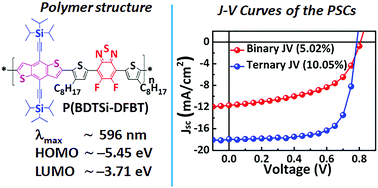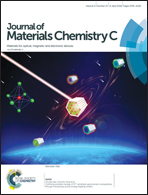Highly crystalline new benzodithiophene–benzothiadiazole copolymer for efficient ternary polymer solar cells with an energy conversion efficiency of over 10%
Abstract
A new alternating polymer P(BDTSi–DFBT), poly(4,8-bis(triisopropylsilylethynyl)-benzo[1,2-b:4,5-b′]dithiophene-alt-5,6-difluoro-4,7-bis(4-octylthiophen-2-yl)benzo[c][1,2,5]thiadiazole), was prepared via Stille polymerization. The determined absorption maximum and optical band-gap (Eg) of P(BDTSi–DFBT) were 590 nm and 1.74 eV, respectively. The calculated highest occupied molecular orbital (HOMO) and lowest unoccupied molecular orbital (LUMO) energy levels of P(BDTSi–DFBT) were −5.45 eV and −3.71 eV, respectively. The X-ray diffraction (XRD) analysis confirmed that P(BDTSi–DFBT) is a crystalline polymer. The binary-polymer solar cells, ITO/PEDOT:PSS/P(BDTSi–DFBT) : PC70BM (1 : 1.5 wt%) + 3 vol% DIO/Al, made from P(BDTSi–DFBT) gave a power conversion efficiency (PCE) of 5.02% with an open-circuit voltage (Voc) of 0.81 V, a short-circuit current (Jsc) of 11.68 mA cm−2, and a fill factor (FF) of 53%. Conversely, the ternary-polymer solar cells, ITO/PEDOT:PSS/PTB7-Th : P(BDTSi–DFBT) : PC70BM (0.8 : 0.2 : 1.5 wt%) + 3 vol% DIO/Al, made with a synthesized medium band-gap P(BDTSi–DFBT) and low band-gap PTB7-Th, offered a maximum PCE of 10.05%, with a Voc of 0.79 V, a Jsc of 17.92 mA cm−2, and a FF of 71%.



 Please wait while we load your content...
Please wait while we load your content...